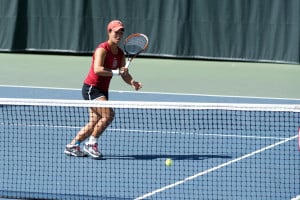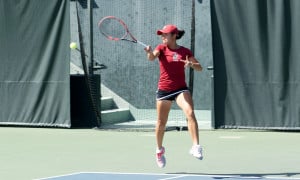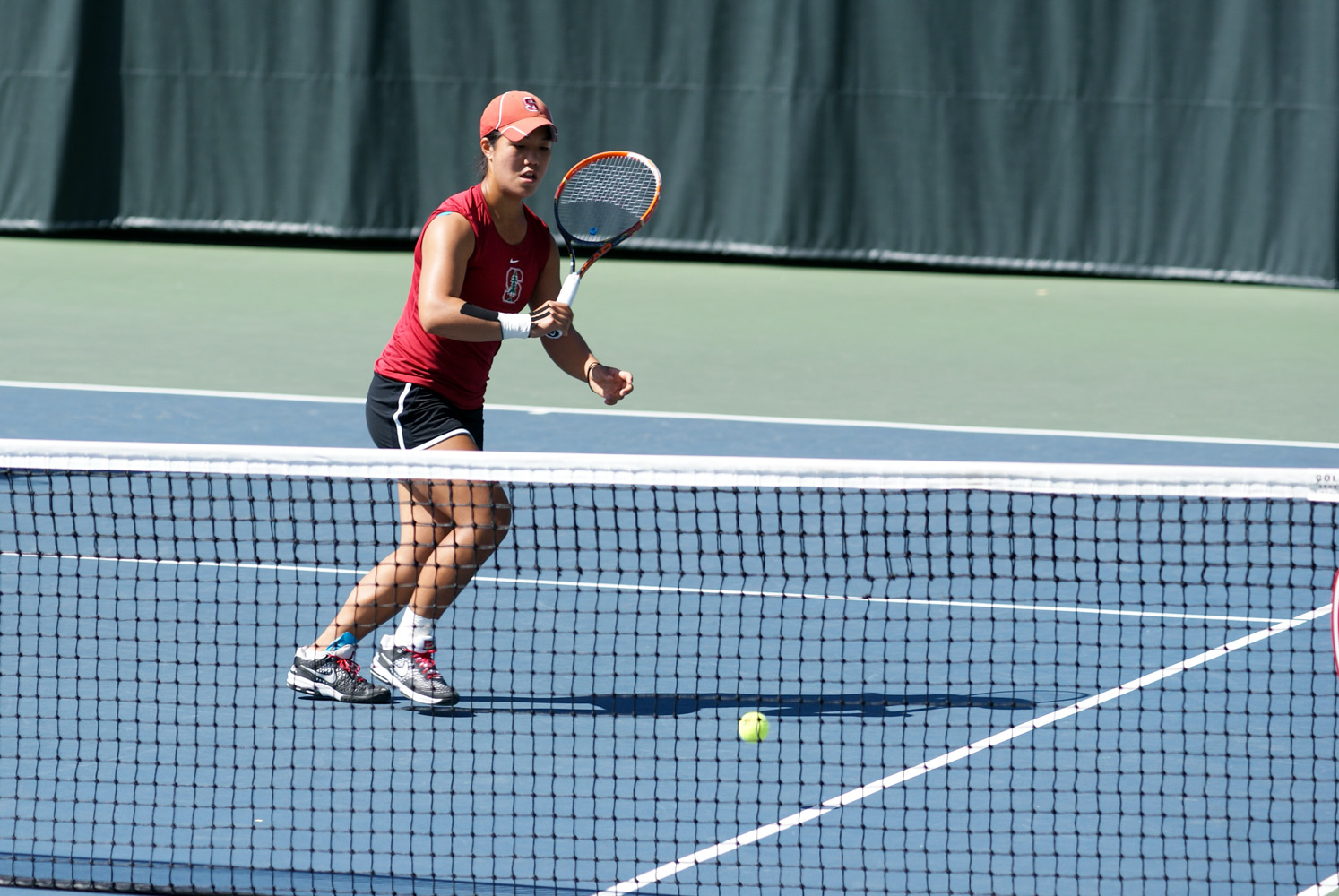Although the trophy count for the No. 11-ranked Stanford women’s tennis team (20-3, 8-2 Pac-12) remains the same after this season, the school’s most decorated team is looking good for the future after a year of solid performances, dramatic upsets and the arrival of a stellar freshman lineup.
Expectations were high for 2014 after the Cardinal captured the singles and team titles at the NCAA Tournament last year, and the squad was up to the task.

After losing two-time NCAA singles champion and 2012 NCAA doubles champion Nicole Gibbs to the professional tour before her senior year, Stanford had a gaping hole to fill in its lineup. Enter Taylor Davidson, Caroline Doyle and Carol Zhao, the trio of freshmen that came in as the top-ranked recruiting class in the country, and quickly proved why they deserved to play for one of the nation’s most legendary tennis programs.
The storyline of the year was, without a doubt, these three young stars, who made up half of head coach Lele Forood’s starting lineup and together accumulated a 90-21 record on the year.
“We sort of formed [a] little freshman group,” Zhao said. “It’s really fun to watch us grow kind of like a mini team, because we’re all new to this, and [there have been] a lot of first experiences for us.”
For the first part of the season, the experiences were typical of Stanford tennis. The Cardinal began the year ranked at No. 1 in January, and did not lose a match until April 4. In fact, the squad was so dominant that when it fell to UCLA (the eventual NCAA champion), Stanford had been the only team in the country without a loss on its record.
A huge part of that success came from the three freshmen, but also from the returning veterans in sophomore Krista Hardebeck, junior Ellen Tsay and senior Kristie Ahn. Ahn, a senior in her last year before going pro, was especially crucial throughout the season. She consistently held down the number one spot in Stanford’s lineup, and also spent the majority of the season among the top five-ranked players nationally.
Tsay and Hardebeck, who both played critical roles in last year’s NCAA success, also made huge contributions on courts five and two, respectively, adding to the team’s collective flawlessness. Over the course of the year, the Cardinal blanked opponents in 13 matches and had their entire lineup ranked in the top 40 at one point, demonstrating the depth and potency of their roster.
With the small exception of the close loss to UCLA, Stanford’s dominance continued right up until Senior Day, the final match of the regular season, which also happened to be the Big Slam against Cal.
Then, for the first time all year, the Cardinal experienced a bad loss, falling 6-1 to their Pac-12 foe, and thus, entered the postseason on a low note.
The disappointment partially carried over to the Pac-12 individual tournament, where the main draw didn’t result in any stellar Cardinal performances. The duo of Ahn and Zhao took second place on the doubles side, but the team still went into the NCAAs clearly desiring improvement.
After entering the NCAAs as the No. 12 seed last year, it felt like déjà vu when the Cardinal entered the tournament at No. 11, but this time without Gibbs to head up the roster.
“We were very insulted that they would seed us that low again, especially after what happened the year before,” Davidson said. “It motivated us in a positive way…because in our mind, we were the number one seed and we could win the whole thing.”
From then on, they certainly played that way, ripping through the first two rounds at home and on through to the round of 16 in Athens, Georgia.
Then came the defining moment of the season: a rematch against Cal in the round of 16. The Cardinal were back in regular form against the Bears, fighting tooth and nail to keep their repeat hopes alive.
The match could hardly have been more dramatic, with Stanford down 3-2 as Davidson fought off cramps and Doyle fought off match points. Once Davidson pulled off a major victory against NCAA singles runner-up Lynn Chi, it came down to Doyle.
“I had my team screaming their heads off for me, and I just knew I had to really dig deep for my team,” Doyle said. “[If] I was going to go down, I was going to go down with everything I had.”
Luckily for the Cardinal, it went the other way, and a Stanford repeat looked possible.
Unfortunately for them, however, the run stopped short in a heartbreaking 4-3 decision against perennial powerhouse North Carolina. Ahn played the deciding match, a tough way for the superstar senior to end her career at Stanford.

The team rallied for the individual side of the NCAAs just days later, where it was the only school to have all six members of the starting lineup entered in the bracket. Ultimately, only Ahn and Zhao made it past the round of 32, but their seasons ended for both doubles and singles in the round of 16 the following day.
That said, the bright spots from the season are countless.
Ahn finally overcame a career riddled with injury to take her place as the team’s number one player, where she fulfilled her role brilliantly and ended the season ranked No. 3 in the country. This week, she was rewarded with first team All-Pac-12 honors, All-America honors and the ITA National Senior Player of the Year award.
Zhao also earned second team All-Pac-12 awards, while Davidson and Hardebeck got honorable mention nods.
As the Gibbs-Ahn era comes to a close, Stanford tennis has nothing to fear. The team won’t be getting any recruits next year, but the young team will get to continue building as the current freshmen take on more leadership.
“I feel like we’re veterans going into next year, almost,” Zhao said. “Because our team is going to be even smaller next year, I feel like we have to take ownership of the team and be responsible for everything going forward.”
Given this year’s performance, that should be no problem for the three capable women.
“We still have room to grow. We have three more years, so we’ll see what happens,” Doyle said.
Whatever lies ahead, Stanford can rest assured that its women’s tennis team isn’t fading anytime soon if Davidson, Doyle, and Zhao have anything to say about it.
“Going through all this together is just making us stronger,” Davidson said. “There are no limits.”
Contact Fiona Noonan at fnoonan ‘at’ stanford.edu.
